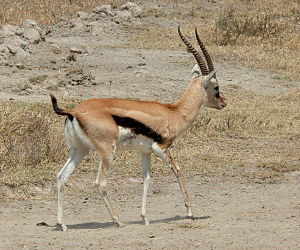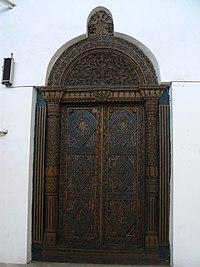
Back بوابة:تنزانيا Arabic Portal:Tansania German Portal:Tanzania Spanish Portail:Tanzanie French Portal:Tanzania Galician Portal:Tanzania Malay Portal:Tanzânia Portuguese Portal:Tanzania Swedish Lango:Tanzania Swahili Портал:Танзанія Ukrainian
 The Tanzania Portal
Tanzania, officially the United Republic of Tanzania, is a country in East Africa within the African Great Lakes region. It is bordered by Uganda to the northwest; Kenya to the northeast; the Indian Ocean to the east; Mozambique and Malawi to the south; Zambia to the southwest; and Rwanda, Burundi, and the Democratic Republic of the Congo to the west. Mount Kilimanjaro, Africa's highest mountain, is in northeastern Tanzania. According to the 2022 national census, Tanzania has a population of nearly 62 million, making it the most populous country located entirely south of the equator. Many important hominid fossils have been found in Tanzania, such as 6-million-year-old Pliocene hominid fossils. In the Stone and Bronze Age, prehistoric migrations into Tanzania included Southern Cushitic speakers who moved south from present-day Ethiopia; Eastern Cushitic people who moved into Tanzania from north of Lake Turkana about 2,000 and 4,000 years ago; and the Southern Nilotes, including the Datoog, who originated from the present-day South Sudan–Ethiopia border region between 2,900 and 2,400 years ago. These movements took place at about the same time as the settlement of the Mashariki Bantu from West Africa in the Lake Victoria and Lake Tanganyika areas. In the late 19th century, the mainland came under German rule as German East Africa, and this was followed by British rule after World War I when it was governed as Tanganyika, with the Zanzibar Archipelago remaining a separate colonial jurisdiction. Following their respective independence in 1961 and 1963, the two entities merged in 1964 to form the United Republic of Tanzania. Tanganyika joined the British Commonwealth and Tanzania remains a member of the Commonwealth as a unified republic. Tanzania is mountainous and densely forested in the north-east, where Mount Kilimanjaro, the highest mountain in Africa and the highest single free-standing mountain above sea level in the world, is located. Three of Africa's Great Lakes are partly within Tanzania. To the north and west lie Lake Victoria, Africa's largest lake, and Lake Tanganyika, the continent's deepest lake, known for its unique species of fish. To the south lies Lake Malawi. The eastern shore is hot and humid, with the Zanzibar Archipelago just offshore. The Menai Bay Conservation Area is Zanzibar's largest marine protected area. The Kalambo Falls, located on the Kalambo River at the Zambian border, is the second-highest uninterrupted waterfall in Africa. Tanzania is one of the most visited tourist destinations for safaris. Selected article -Dame Jane Morris Goodall DBE (/ˈɡʊdɔːl/; born Valerie Jane Morris-Goodall; 3 April 1934), formerly Baroness Jane van Lawick-Goodall, is an English zoologist, primatologist and anthropologist. She is considered the world's foremost expert on chimpanzees, after 60 years' studying the social and family interactions of wild chimpanzees. Goodall first went to Gombe Stream National Park in Tanzania to observe its chimpanzees in 1960. She is the founder of the Jane Goodall Institute and the Roots & Shoots programme, and she has worked extensively on conservation and animal welfare issues. As of 2022, she is on the board of the Nonhuman Rights Project. In April 2002, she was named a United Nations Messenger of Peace. Goodall is an honorary member of the World Future Council. (Full article...)General images -The following are images from various Tanzania-related articles on Wikipedia.
This month in Tanzanian history
Wildlife of Tanzania - Credit: Haplochromis
The Thomson's gazelle (Eudorcas thomsonii) is one of the best-known gazelles. It is named after explorer Joseph Thomson and, as a result, is sometimes referred to as a "tommie". It is considered by some to be a subspecies of the Red-fronted Gazelle and was formerly considered a member of the genus Gazella within the subgenus Eudorcas, before Eudorcas was elevated to genus status. Did you know ...
CategoriesWikiProjectsRecognised contentSelected panorama -Mikumi National Park, a national park in Mikumi, near Morogoro, Tanzania. The park was established in 1964, currently covers an area of 3230 km² and is the fourth largest in the country. The landscape of Mikumi is often compared to that of the Serengeti. The road that crosses the park divides it into two areas with partially distinct environments. The area north-west is characterized by the alluvial plain of the river basin Mkata. The vegetation of this area consists of savannah dotted with acacia, baobab, tamarinds, and some rare palm. In this area, at the furthest from the road, there are spectacular rock formations of the mountains Rubeho and Uluguru. The southeast part of the park is less rich in wildlife, and not very accessible.
Uganda–Tanzania War -Articles here focus upon aspects of the Uganda–Tanzania War. These are all Good articles that meet a core set of high editorial standards.
The Battle of Karuma Falls was one of the last battles in the Uganda–Tanzania War, fought between Tanzania and Uganda Army troops loyal to Idi Amin on 17 May 1979. Soldiers of the Tanzania People's Defence Force attacked Ugandan forces at the bridge over the Nile River at Karuma Falls. Tanzania's 205th Brigade was tasked with advancing from Masindi to Gulu, taking a route which passed over the Karuma Falls Bridge. The brigade assaulted the crossing on the morning of 17 May with tanks and artillery and one of its battalions ran over the bridge to attack the Ugandan positions. The Ugandans destroyed a TPDF tank, delaying the Tanzanians long enough to board buses and retreat to Gulu. The Tanzanians secured Karuma Falls before capturing Gulu several days later. (Full article...) TopicsSelected picture - Credit: Paul Brockmeyer
A traditional carved door showing Arabic calligraphy in Zanzibar. Zanzibar has a long history of Arab influence and was controlled by the Sultan of Oman from 1698–1861. ...Archive — Nominations
Related portalsThings you can doAssociated WikimediaThe following Wikimedia Foundation sister projects provide more on this subject:
Discover Wikipedia using portals | ||||
© MMXXIII Rich X Search. We shall prevail. All rights reserved. Rich X Search







































































